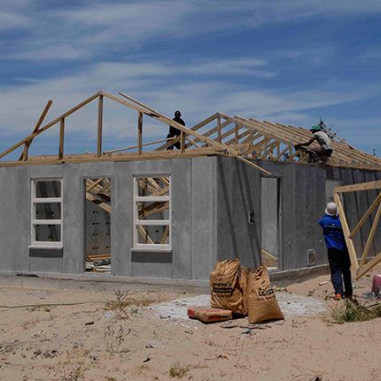Innovative Building Technologies (IBTs) in South Africa

South Africa has been exploring innovative building technologies (IBTs) to address the housing crisis and improve the quality of buildings for some time. Despite this, the uptake of IBTs to assist in faster and more cost-effective delivery of houses and social infrastructure has generally been slow. This resource page is the start of a collection of various sources and academic studies on IBTs in South Africa. These may provide an overview of the current state of IBTs, the benefits and challenges of implementing them, best practices, and national/international case studies. Resources in the collection may also highlight the opportunities and barriers for IBT adoption in different contexts and sectors and offer recommendations and guidance for future research and development.
Built environment professionals working in the IBT sector are invited to email ukesa@csir.co.za to suggest additional sources to add to this collection in an effort to raise awareness, inspire innovation, and foster collaboration among those who are interested in or are working with IBTs.
Acronyms
- Alternative Building Technology (ABT)
- Innovative Building Technologies (IBTs)
- Science, Technology and Innovation (STI)
Annotated Bibliography
Ordered by year of publication, most recent to earliest.
This journal article provides a comparative evaluation of the affordability of some readily available Innovative Building Technologies in 2020 within the South African construction industry. The authors found that the combination of an increase in the subsidy grant for the top structure, and the use of cheaper and more durable IBTs, could improve affordability.
This journal article assesses the perception of local experts and end users of an Alternative Building Technology (ABT), the sandbag material technology, for developing a sustainable affordable housing solution in South Africa. The authors find that reasons for using the sandbag material technology include sustainability, affordability, job creation potentials, fire resistance and earthquake resistance. In addition to this, they highlight that the sandbag material technology contributes to a low carbon footprint in the atmosphere.
In this Master’s research project, the author investigates the extent of use and the barrier to the social acceptance of Alternative Building Technology (ABT), focusing on sandbag building technology in housing construction in South Africa. A framework is developed as part of this study. This, the author suggests, has the potential to aid South African housing stakeholders in clearly understanding how to promote the adoption and social acceptance of sandbag building technology to address the country’s housing crisis.
This document is the proceedings report of the Department of Science and Innovation in partnership with the Academy of Science of South Africa on the Innovation for Inclusive Development seminar series. These proceedings present preliminary findings and recommendations based on policy document analysis and a survey of twelve (12) sector departments, who were encouraged to adapt Science, Technology and Innovation (STIs) in their policies and programmes.
This journal article presents a case study of the use of innovative building technologies (IBTs) to address housing challenges in South Africa. It focuses on the AV Light Steel project in Potchefstroom, South Africa, and examines the benefits and challenges of using IBTs in the construction of affordable housing. The authors concluded that despite promising prospects of future use, this emerging IBT industry has not, despite government insistence and encouragement for the adoption of IBTs, received significant support or endorsement.
CSIR, & DSI. (2021). STI4SHS Roadmap. Department of Science and Innovation.
In this handbook, the Department of Science and Innovation, the Department of Human Settlements and the Scientific and Industrial Research (CSIR) Smart Places define a ten-year (2020–2029) Science, Technology and Innovation for Sustainable Human Settlements (STI4SHS) Roadmap. This is essentially an action plan to guide the implementation and scaling up of technologies and innovations in the Sustainable Human Settlements sector in support of the National Department of Human Settlement’s Innovation for Transformative Technologies Framework, the STI White Paper, the DSI Decadal Plan and the White Paper on Sustainable Human Settlements. The intention is that this ultimately supports and positions government as an enabler of innovation in South Africa.
This document reflects the proceedings of the Exploring the Prospects of using 3D Printing Technology in the South African Human Settlements webinar that forms part of the Innovation for Inclusive Development Seminar Series (online). These proceedings present preliminary findings from a study conducted by the UJ to explore the potential use of 3D printing technology in human settlements. The following were addressed: 1. The viability of 3D printing technology; 2. Cost comparison of 3D printed house to conventional construction; and 3. Preliminary perceptions on 3D printing of houses. There was a unanimous consensus that collaborative efforts from all stakeholders are key to take advantage of this niche technology.
In this book chapter, the author presents finding from a study that explored the implementation of selected IBTs in housing developments. He finds substantial scope for innovative technology to improve the performance of low-cost housing in South Africa, but also highlights the difficulty small contractors have in assimilating innovative technology.
National Home Builders Registration Council (NHBRC). (2019). IBT Dynamic Database Spreadsheet.
In this spreadsheet, the National Home Builders Registration Council (NHBRC) presents a database of IBTs along with a list of projects already built using each technology.
This paper investigated a few case studies where IBTs had been used in housing developments. It collated the data from the projects, analysed the challenges and made recommendations. The major challenge identified by the author in the implementation of the IBTs was the construction cost. A cost analysis of constructing with IBTs was presented in the paper, this demonstrated that the costs were comparable to the brickwork costs.
This publication presents the Gauteng Human Settlements’ Research conducted to ensure that the knowledge generated through research remains accessible to stakeholders within the public, private and civil society sectors, increases institutional capacity and improves coordination for better spatial targeting. This document focuses on (1) The role of innovative building technologies in achieving sustainable human settlements; (2) Effectively dealing with Gauteng’s housing demand and housing backlog challenges; (3) Revisiting housing allocation; and (4) a cost-benefit analysis on inclusionary housing.
This paper investigates the requirements for incorporating quality into the procurement of Agrément South Africa certified IBTs in the delivery of construction projects. The author finds that the “choice of contracting and procurement arrangements needs to be guided by the Conditions of Certification for IBTs” and proposes a two-step contractor appointment strategy that may satisfy these Conditions.
In this book chapter, the author examines the performance of innovative building technologies (IBTs) in South Africa’s climatic zones. It provides an overview of the different types of IBTs available and discusses their suitability for different climatic conditions.
In this book chapter, the author analyses, compares and validates the efficacy of IBT (time, cost, and performance) in accelerating green and sustainable building in South Africa. The study shows that IBTs have the potential to outperform conventional building technologies against selected indicators without a loss of quality. It also shows that both cost and time were reduced, whilst working conditions were greatly improved.



Comments